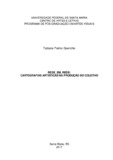| dc.creator | Guerche, Tatiana Palma | |
| dc.date.accessioned | 2018-07-04T19:36:09Z | |
| dc.date.available | 2018-07-04T19:36:09Z | |
| dc.date.issued | 2017-05-30 | |
| dc.identifier.uri | http://repositorio.ufsm.br/handle/1/13662 | |
| dc.description.abstract | The dissertation "REDE_EM_REDE: ARTISTIC CARTOGRAPHS IN THE PRODUCTION OF THE COLLECTIVE", was developed in line of research "Art and Technology" of PPGART /UFSM. Starting from the production of digital collaborative narratives, we investigated how a proposal in web art can update network potentials in the contemporaneity. We're questioning how to operate possible connections through art and technology in a poetics of collaborative web art, and specifically, as informational geographic networks - apparently stagnant and deactivated - can be reconnected in cyberspace. These narratives have as main theme the stories of individuals connected to the railway communities in the central region of the State of Rio Grande do Sul. The aim was to put in communication flow the scenarios of each city and the organization of a virtual community around the railway legacy. For the organization of a virtual community were used different digital platforms in network such as: Facebook, Instagram, YouTube, Wix.com, and the application CODATA (Collaborative Data Community), developed by LabInter (Laboratory Interdisciplinary Interactive). The acts of this research were articulated through cartography, since no object was represented, and, yes, processes and acts were followed, as emphasized by Gilles Deleuze, Felix Guattari and Virginia Kastrup. In dialoguing with the question of narrative we look for in Walter Benjamin references about the narrative in a pre-digital era and how this narrative was understood before the interaction of the human with the digital of contemporaneity. In this sense, the Actor-Network Theory (TAR) coined by Bruno Latour was the theoretical basis for the discussions about human-non-human interactions and the formation of networks. The concept of informational territory developed by André Lemos, was used to elucidate the formation of digital cartographies about the city. In this way, the dissertation contributes to contemporary art, especially with art and technology, with the elaboration of a web art proposal, produced in a collaborative and shared network. This research reinforces the political character of art, pointing out that from visualities and sensitive mappings, the collective is produced. | eng |
| dc.description.sponsorship | Coordenação de Aperfeiçoamento de Pessoal de Nível Superior - CAPES | por |
| dc.language | por | por |
| dc.publisher | Universidade Federal de Santa Maria | por |
| dc.rights | Attribution-NonCommercial-NoDerivatives 4.0 International | * |
| dc.rights.uri | http://creativecommons.org/licenses/by-nc-nd/4.0/ | * |
| dc.subject | Arte contemporânea | por |
| dc.subject | Arte e tecnologia | por |
| dc.subject | Narrativas digitais | por |
| dc.subject | Teoria ator-rede | por |
| dc.subject | Cartografias artísticas | por |
| dc.subject | Contemporary art | eng |
| dc.subject | Art and technology | eng |
| dc.subject | Digital narratives | eng |
| dc.subject | Theory actor-network | eng |
| dc.subject | Artistic cartography | eng |
| dc.title | Rede_em_rede: cartografias artísticas na produção do coletivo | por |
| dc.title.alternative | Rede_em_rede: artistic cartographs in collective production | eng |
| dc.type | Dissertação | por |
| dc.description.resumo | A dissertação “REDE_EM_REDE: CARTOGRAFIAS ARTÍSTICAS NA PRODUÇÃO DO COLETIVO”, foi desenvolvida na linha de pesquisa “Arte e Tecnologia” do PPGART/UFSM. A partir da produção de narrativas digitais colaborativas, investigou-se como uma proposta em web arte pode atualizar potenciais em rede na contemporaneidade. Problematizou-se como operar possíveis conexões por meio da arte e tecnologia em uma poética em web arte colaborativa, e, especificamente, como redes geográficas informacionais - aparentemente estagnadas e desativadas - podem ser reconectadas no ciberespaço. Tais narrativas têm como temática principal as histórias de indivíduos ligados às comunidades ferroviárias na região central do Estado do Rio Grande do Sul. O intuito foi colocar em fluxo comunicacional os cenários de cada cidade e a organização de uma comunidade virtual em torno do legado ferroviário. Para a organização de uma comunidade virtual foram utilizadas diferentes plataformas digitais em rede como: Facebook, Instagram, YouTube, Wix.com, e o aplicativo CODATA (Comunidade Colaborativa de Dados), desenvolvido pelo LabInter (Laboratório Interdisciplinar Interativo). As ações dessa pesquisa foram articuladas por meio da cartografia, uma vez que não se representou um objeto, e, sim, acompanhou-se processos e ações, como enfatizam Gilles Deleuze, Felix Guattari e Virginia Kastrup. Ao dialogarmos com a questão da narrativa buscamos em Walter Benjamin referências sobre a narrativa numa era pré-digital e como essa narrativa era entendida antes da interação do humano com o digital da contemporaneidade. Nesse sentido a Teoria Ator-Rede (TAR) cunhada por Bruno Latour, foi o embasamento teórico para as discussões sobre interações entre humanos e não-humanos, e a formação das redes. O conceito de território informacional desenvolvido por André Lemos, foi utilizado para elucidar a formação de cartografias digitais sobre a cidade. Dessa forma, a dissertação contribui com a arte contemporânea, especialmente, com a arte e tecnologia, com a elaboração de uma proposta em web arte, produzida de forma colaborativa e compartilhada em rede. Esta pesquisa reforça o caráter político da arte, apontando que a partir de visualidades e mapeamentos sensíveis, o coletivo é produzido. | por |
| dc.contributor.advisor1 | Oliveira, Andréia Machado | |
| dc.contributor.advisor1Lattes | http://lattes.cnpq.br/7243757837987821 | por |
| dc.contributor.referee1 | Minuzzi, Reinilda de Fátima Berguenmayer | |
| dc.contributor.referee1Lattes | http://lattes.cnpq.br/1234650265478193 | por |
| dc.contributor.referee2 | Hildebrand, Hermes Renato | |
| dc.contributor.referee2Lattes | http://lattes.cnpq.br/6263913436052996 | por |
| dc.creator.Lattes | http://lattes.cnpq.br/7940493256189014 | por |
| dc.publisher.country | Brasil | por |
| dc.publisher.department | Artes | por |
| dc.publisher.initials | UFSM | por |
| dc.publisher.program | Programa de Pós-Graduação em Artes Visuais | por |
| dc.subject.cnpq | CNPQ::LINGUISTICA, LETRAS E ARTES::ARTES | por |
| dc.publisher.unidade | Centro de Artes e Letras | por |



